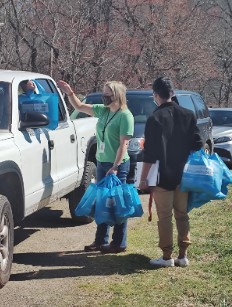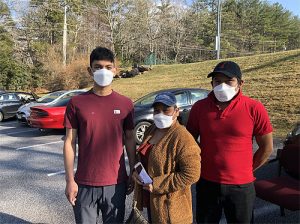By Yolanda Pinzon Uribe,
Community Health Program
Vecinos
 We know that our communities are in different COVID-19 “Levels”, but also we know that they need to have by hand a simple Kit and tool that help them to decide what prevention steps to take to be out of risk – as much as they can.
We know that our communities are in different COVID-19 “Levels”, but also we know that they need to have by hand a simple Kit and tool that help them to decide what prevention steps to take to be out of risk – as much as they can.
Our CHW most of the time have bags carrying flyers with basic information that exists already from CDC printed by HT and Kepro and with masks, hand sanitizer and rapid test. These bags that we call COVID-KITS have been at this moment the best way for us to introduce our-self and start a new conversation with the community about covid.
And I said a “new conversation” because we are not at the beginning of the pandemic, we are in the transition phase and that means that it’s time for a different approach and different strategy.
Our work now is not different from building relations and trust. We need to be empathic and “motivational” If it is true that People who are up date on vaccines have much lower risk of severe illness and death from COVID-19 compared with unvaccinated people, we also know that people who suffer -for example- from obesity, chronic diseases and/or live in crowded conditions or is immunocompromised, vaccinated or not, are still at risk of having covid.
 In Vecinos, we would like to flit up the tortilla around… Think about this question: Do you know if you are – still at high risk for COVID? We would like to put the conversation around WHAT can put you at risk. Put in people’s hands to speak about their style of life, their health conditions and how we can work from there to make a plan to improve their health and prevent COVID-19 as one of the first causes of death.
In Vecinos, we would like to flit up the tortilla around… Think about this question: Do you know if you are – still at high risk for COVID? We would like to put the conversation around WHAT can put you at risk. Put in people’s hands to speak about their style of life, their health conditions and how we can work from there to make a plan to improve their health and prevent COVID-19 as one of the first causes of death.
It is time for them to make a plan and stay up to date with COVID-19 vaccines and get tested when they have symptoms. Wearing a mask indoors in public becomes a simple recommendation.
We are in a transition that we must all make: civil organizations, the state, individuals and communities. That means rethinking outside of the box and getting people involved and co-responsible in building plans to improve their own well-being, protect their health, and avoid preventable illness and death.
